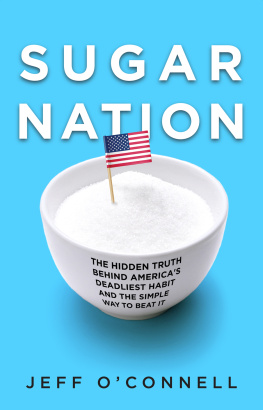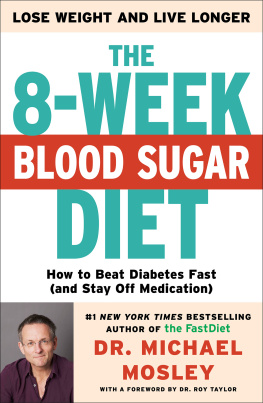
Contents
For Joe Weider
We shape our tools and then our tools shape us.
Marshall McLuhan
S ugar and temptation have enjoyed a long and colorful history, since the Beginning. Adam and Eve were lounging around blissfully in the Garden of Eden when Eve offered Adam an applefructose and glucose, surrounded by some fiber. Tempted, Adam took a bite. Theres no way to know for certain, but chances are that he liked this new sensation very much. After all, sugar is sweet, and sweet is good.
Were they here today, Eve could sabotage Adam just as easily by taking him to a drive-through, ordering a number three, and handing him a bag filled with a double cheeseburger and fries, along with an up-sized soda. And if Adam were tempted by the sweet taste and convenience, hed probably end up with a gut, high triglycerides, and type 2 diabetes.
Fast-forward from the days of Let There Be Light. Sugarcane grows for the first time in New Guinea, a Polynesian island. Enterprising merchants carry the plant along trade routes to China and India, where in 500 B.C. , enterprising scientists notice that when boiled, sugarcane leaves behind a sort of fairy dust. Workdays dont yet begin with an espresso macchiatoalas, no Starbucks yetbut it doesnt take long for tongues to be tantalized by the addition of those tiny crystals to various foods and beverages. That original sugar was actually pretty healthy, containing protein, fiber, and other nutrients.
Sugar reaches Europe in the Middle Ages, further firing up the Crusaders. Columbus takes some sugarcane along with him to the New World, where, in another five hundred years or so, it will prove deadlier than guns or germs. The first sugarcane on U.S. shores is planted in Louisiana in the mid-eighteenth century. Over time, our appetite for all things sweet grows, and food scientists learn clever new ways to feed an ever-growing addiction, to the tune of 160 pounds of sugar a year. Thats how much the average American now consumes.
Sugar has gone from expensive to cheap, from healthy to unhealthy. Thats because most of its redeeming value has been processed away. Sugar is now dense in energy, but those calories are largely empty.
Along with sweetening food, sugar also helps other calories generate longer shelf lives. It preserves, la salt. Sprinkle some on a slab of meat hanging from the rafters of Grandpa Jeds barn, or on some lunch meat shrink-wrapped for the supermarket, and those foods wont spoil as fast. If nothing else, you see, sugar has staying power.
Like poor Adam, I never knew what hit me. Up until the fall of 2006, I ate and drank a lot of sugar, largely unaware of type 2 diabetes, because only the old and the overweight need worry about it, I thought. How wrong I was. My ignorance is inexcusable, given that I wrote for a magazine called Mens Health , but it also goes a long way toward explaining why the disease has spread across America with the persistence of a glacier and the devastation of a wildfire. As it stands, one in three American adults has type 2 diabetes or its preamble, prediabetes. Remarkably, one in four diabetics is in the dark about his or her condition. One of them might be you.
If you are, this book will shine a bright light on the enemy lurking within. Please, dont fear that revelation. Its what you do next that matters the most. But the time to start is now. Medical self-awareness, in fact, could end up saving your life. You dont have to be diabetic to benefit from controlling your blood sugar, because everyone can use the know-how in this book to boost their energy, sharpen their focus, and live longer and more healthfully.
Diabetes has snuck up on America because insulin resistance, its root cause, sneaks up on Americans. Its the invisible cause of an invisible disease. By the time someone learns theyre prediabetic, insulin resistance is already in charge, and probably has been for many years. Such stealth explains why no oneyoung or old, thin or overweight, man or womanshould assume theyre safe from this deadly disease. Diabetes snuck up on me too, because I was neither old nor overweight, and because I was ignorant of my own family history. When I knew the truth, I was stunned, and dazed, and a little frightened. Because I didnt know any better.
I didnt know, for example, that the chemicals released by sugar consumption travel the same brain pathways that heroin does, and that when were stressed, or sad, the foods that can produce this feeling exert a magnetic pull.
I didnt know that the best way to lose weight and keep it off is to do the exact opposite of what the majority of mainstream weight-loss experts recommend.
I didnt know that when you receive your first diabetes drug prescription, thats just the starter kit, and no one knows that better than the doctors and drug makers.
I didnt know that blood sugar volatility is a dangerously overlooked risk factor for cardiovascular disease, and that most diabetes tests dont measure it.
I didnt know that most physicians dont do a very good job of counseling their patients on lifestyle decisions, particularly when it comes to diet and physical activity.
I didnt know that when you develop insulin resistance and neglect it, the condition inevitably worsens. Whether the statistical threshold to diabetes is crossed in three months or three years, the toll is a heavy one indeed. Ive seen it for myself.
What I did know? That my limbs, heart, and kidneys were worth a hell of a lot more to me than hamburger buns, French fries, and glazed doughnuts. So I changed my ways with a vengeance. It began with a primal survival urge, suddenly awoken. But I was also fueled by curiosity, about how this disease works and why its so deadly; and anger, that type 2 diabetes has this aura of inexorability, when it is in fact preventable and manageable, if not reversible. I became determined not to become one of the diseases victims, and to inform others while waging my own personal battle.
Now, of course, I know much more than that. My four-year diabetes journey only matters as a telescope for viewing the story that matters: the full extent of our national sugar sickness. Sugar gave rise to the slave trade; now sugar has enslaved us. As a result, Americas most preventable disease, type 2 diabetes, has taken over instead. Its bad enough that the American disease of the twenty-first century is man-made, but its ascent to Public Health Enemy Number One represents a collective failure breathtaking in more ways than one.
Many people who are fighting a disease sometimes are thankful for the perspective gained from learning how fleeting life can be. They appreciate things more. I understand that. But when I say that prediabetes gave me a new lease on life, take those words literally. Im a much better person now than I was when I learned of my own blood-sugar meltdown. Im healthier, fitter, more focused, and more energized than I ever was before.
Make no mistake about it. Diabetes is an awful disease. Should it gain the upper hand, death itself can seem a welcome reprieve. But if you recognize the warning signs early enough and take corrective action, youll do more than beat this disease. Youll also transform your life.
First, though, you need a plan of action. Unfortunately the industry that has mushroomed around type 2 diabetes measures success in approvals for new drugs, revenue earned, and money raised, not in suffering avoided or lives saved. Whether I was sitting in an exam room with my doctor, visiting the largest diabetes conferences in the world, reading journal articles, or interviewing experts at major universities, I kept coming back to the same realization over and over again. To avoid a long and torturous demise at the hands of diabetes, Id have to hit the road to figure out this thing on my own.
Next page












